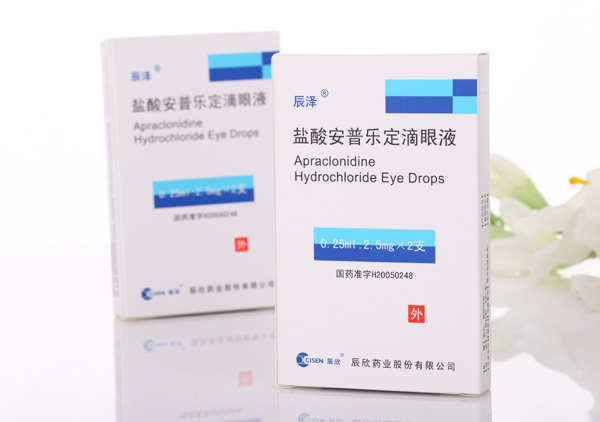Description: Apraclonidine Hydrochloride Eye Drops contains apraclonidine hydrochloride, an alpha adrenergic agonist, in a sterile isotonic solution for topical application to the eye. It is indicated for short-term adjunctive therapy in patients on maximally tolerated medical therapy who require additional IOP reduction. Apraclonidine hydrochloride is a white to off-white powder and is highly soluble in water. Its chemical name is 2-[(4-amino-2, 6 dichlorophenyl) imino]imidazolidine monohydrochloride.
Pharmacological effects: Apraclonidine hydrochloride is relatively selective alpha-2-adrenergic agonist. When instilled in the eye, Apraclonidine Hydrochloride Eye Drops, has the action of reducing elevated, as well as normal, intraocular pressure (IOP), whether or not accompanied by glaucoma. Apraclonidine Hydrochloride Eye Drops has minimal effect on cardiovascular parameters. Elevated IOP presents a major risk factor in glaucomatous field loss. The higher the level of IOP, the greater the likelihood of optic nerve damage and visual field loss. Apraclonidine 0.5% Ophthalmic Solution has the action of reducing IOP. The onset of action of apraclonidine can usually be noted within one hour, and maximum IOP reduction occurs about three hours after instillation. Aqueous fluorophotometry studies demonstrate that apraclonidine's predominant mechanism of action is reduction of aqueous flow via stimulation of the alpha-adrenergic system.Apraclonidine Hydrochloride Eye Drops, because of its alpha adrenergic activity, is a vasoconstrictor. Single dose ocular blood flow studies in monkeys, using the microsphere technique, demonstrated a reduced blood flow for the anterior segment; however, no reduction in blood flow was observed in the posterior segment of the eye after a topical dose of Apraclonidine Hydrochloride Eye Drops. Ocular blood flow studies have not been conducted in humans.
Pharmacokinetics: Topical use of Apraclonidine 0.5% Ophthalmic Solution leads to systemic absorption. Studies of Apraclonidine Ophthalmic Solution dosed one drop three times a day in both eyes for 10 days in normal volunteers yielded mean peak and trough concentrations of 0.9 ng/mL and 0.5 ng/mL, respectively. The half-life of Apraclonidine Ophthalmic Solution was calculated to be 8 hours.
Indications: Apraclonidine Hydrochloride Eye Drops is indicated for short-term adjunctive therapy in patients on maximally tolerated medical therapy who require additional IOP reduction.
Precautions: Close monitoring of cardiovascular parameters in patients with impaired renal function is advised if they are candidates for topical apraclonidine therapy. Close monitoring of cardiovascular parameters in patients with impaired liver function is also advised as the systemic dosage form of clonidine is partly metabolized in the liver.While the topical administration of Apraclonidine Hydrochloride Eye Drops had minimal effect on heart rate or blood pressure in clinical studies evaluating glaucoma patients, the preclinical pharmacology profile of this drug suggests that caution should be observed in treating patients with severe, uncontrolled cardiovascular disease, including hypertension. Apraclonidine Hydrochloride Eye Drops should be used with caution in patients with coronary insufficiency, recent myocardial infarction, cerebrovascular disease, chronic renal failure, Raynaud's disease, or thromboangiitis obliterans. Caution and monitoring of depressed patients are advised since apraclonidine has been infrequently associated with depression. Apraclonidine can cause dizziness and somnolence. Patients who engage in hazardous activities requiring mental alertness should be warned of the potential for a decrease in mental alertness while using apraclonidine. Use of Apraclonidine Hydrochloride Eye Drops can lead to an allergic-like reaction characterized wholly or in part by the symptoms of hyperemia, pruritus, discomfort, tearing, foreign body sensation, and edema of the lids and conjunctiva. If ocular allergic-like symptoms occur, Apraclonidine Hydrochloride Eye Drops therapy should be discontinued. Do not touch dropper tip to any surface as this may contaminate the contents. Apraclonidine should not be used in patients receiving MAO inhibitors.
Adverse reaction: The most commonly reported events leading to discontinuation included , hyperemia, pruritus, tearing, discomfort, lid edema, dry mouth, and foreign body sensation.

